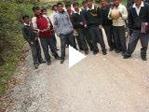Leaving Lima, I biked south along Peru’s desert coast. Confronting headwinds and fog, I decided to turn inland and followed an impressive canyon into the Andes. Climbing above 13,000 feet, I found the land was grazed by llamas and alpaca, and one night I even camped next to a flock of llamas (video and photo bottom left and center).
After spending a few days in the city of Ayacucho (where I visited Institucion Educativo Luis Carranta), I continued on, this time on one lane dirt roads through the Andes. People live along these roads — every inch of land that can be farmed in the mountains is farmed or grazed. These people don’t often see foreigners, and everyone wanted to talk to me.
Everyone along this road speaks Quechua, a native tongue, as their first language, yet they almost all also speak Spanish. I learned a few useful phrases in Quechua (‘I am 27 years old’, ‘I come from the United States’, ‘I am hungry’, ‘you are pretty’), and found these extremely useful in making friends along the road.
Biking by one school, a number of the students rushed out of their recess to talk to me, and I talked to them about my project. The biggest environmental problems here, I think, are deforestation and poor trash disposal. Click on the video on the right, and you can see students saying ‘take care of the environment’ in Quechua.
People have little money along this road. The most people make in a given day here is about 10 soles, or 3 dollars, with many making far less. Some people beg for money, and people always ask me about money — how much does my bike cost? how much can you make in the U.S.? — and these are my least favorite questions. I never tell them how much my bike costs (I now reply with ‘how much does your best friend cost?’), but it is hard to be fully comfortable knowing that my gear cost far more than it costs to make their houses. Everyone I stayed with seems to have enough to eat (and often share it with me), but, one man whose house I camped next to explained that there are people — people who don’t have land or who have mental problems — along this road who simply don’t have enough to eat.
In one town, some kids came out and pushed my bike from behind, helping me up a hill. They begged for money, and I gave them some bread. They pushed me some more and then one of them opened up the rear of my pannier and tried to steal my tent stakes. I yelled, turned around, and quickly caught the kid. The locals heard me yell, and soon the entire town crowded around me, and we had a friendly but awkward conversation. I got my tent stakes back, but somehow didn’t feel good about it.
The majority my interactions, however, were like those I had with Edgar. I asked Edgar where I could buy matches. He responded by giving me some matches. I gave him my business card. He gave me some oranges. I gave him some cookies and showed him I could count to ten in Quechua. He invited me in for lunch, and you can see him on the left in his kitchen. And then there were the 3 different families whose houses I camped next to, and who all invited me and fed me in their kitchens.
After many more thousands of feet of climbing and passing an impressive Incan ruin, I arrived in Abancay, where the pavement began again. After two more days and 12,000 feet of climbing, I rolled into Cusco, Peru’s tourism capital and the former capital of the Inca Empire.















bombero bombero bombero quiero ser bombero bombero!
we want that photo of us up on your blog!
i have told my mum and she is expecting it.
happy travels xxx
Hi Dave,
are the people getting shorter as you go south, or are you getting taller? I know that height and nutrition are linked, and I know in your last post you described how poor (and for the most part generous) people in this region are, is this part poorer than others you have been?
julia